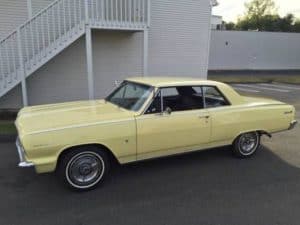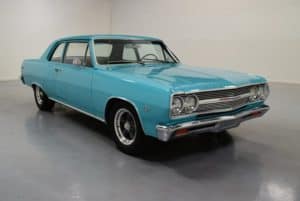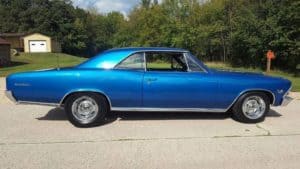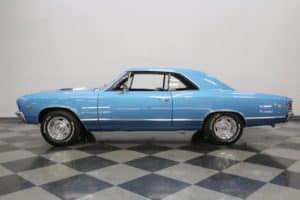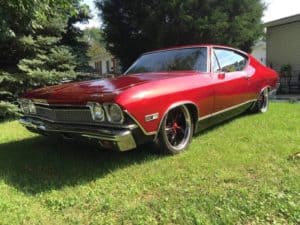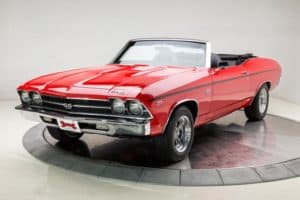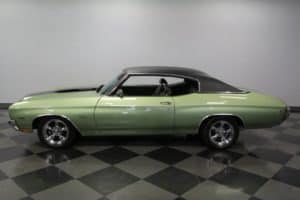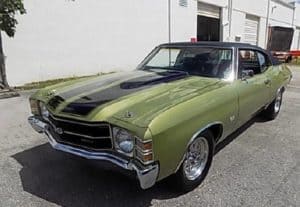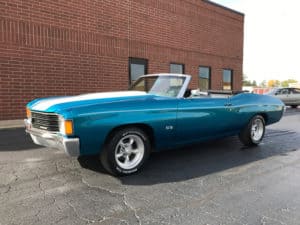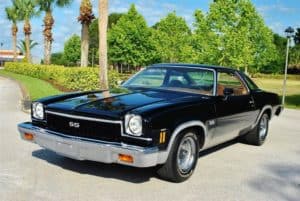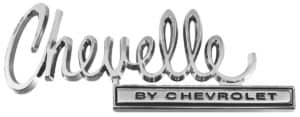
The Chevelle SS represented Chevrolet’s entry into the muscle car battle. Early 1964 and 1965 Chevelles had a Malibu SS badge on the rear quarter panel (the sought-after Z16 option had the emblem on the front fender, where 201 Malibu SS396s were produced); after 1965, the Malibu SS badging disappeared except for those sold in Canada. The Chevelle SS, which became a regular series of its own in 1966 called the SS396, was the high performance version and had its own line of engines and performance equipment. The performance engines available included 396 CID V8s – rated at 325, 350 and 375 hp respectively. The SS396 series only lasted three years from 1966 through 1968 before being relegated to an option status just like air conditioning or a radio.
For Chevelle enthusiasts who wanted a high-performance mid-sized car but with a hot small-block V8, rather than the big-block found in the SS396, the regular Chevelle and Malibu models were available with a 350-horsepower 327 cubic-inch V8 (option code L-79) in 1965 and 1966. That same engine was also offered for , but downrated “on paper” to 325 horsepower, the same as the standard 396 found in the SS396.
For the 1969 model year, the SS396 series was dropped and the Super Sport became a performance option. In 1969 the SS option could be ordered on the 300 Deluxe 2-dr Sport Coupe and 2-dr sedan as well as the Malibu 2-dr Sport Coupe, convertible. In 1970 the SS option was limited to the Malibu series (2-dr Sport Coupe, convertible, and El Camino). In both 1969 and 1970 the SS option included the 396/402 as the base engine keeping the option alive as a performance-oriented choice. This changed in 1971 when the SS option could be ordered with any optional V8 and became more of a dress-up option than a performance option.
Prior to 1970, GM had a restriction stating that no mid-size car could have an engine with a displacement over 400 CID, though some inventive people figured out ways around this through the dealership; 1968 and 1969 were the times of the COPO (Central Office Production Order), in which a car was ordered by the dealer with a larger than allowed engine in it for racing purposes.
In 1970 GM dropped the displacement rule, and that was when the bigger engines were available as regular production options, resulting the addition of an SS454 line option to the existing SS396 option. The first change was that the 396 engine was bored out to 402 CID , but the car kept the 396 badging as so much advertising had been put into the 396 namesake that they didn’t want to change it. Most notable was the 454 CID LS5 V8 rated at 360 hp and the LS6 at 450 hp. It was the 454 that made the Chevelle a legend. The LS6, with 450 hp and 500 ft/lb of torque, would rocket the Chevelle through the 1/4 mile in low to mid-13 second times at 105 to 108 mph. In fact, the stock LS6 at 450 hp produced more horsepower than any other stock production engine offered by any manufacturer during the golden age of muscle cars (which most people consider to be from 1965 to 1972).
For 1971, GM mandated that all divisions design their engines to run on lower-octane regular, low-lead or unleaded gasoline due to tightening emission requirements and in anticipation of the catalytic converter that would be used on 1975 and later models, necessitating the use of unleaded fuel. To permit usage of the lower-octane fuels, all engines featured low compression ratios (9 to 1 and lower; well below the 10.25-11.25 to 1 range on high performance engines of 1970 and earlier). This move reduced horsepower ratings on the big-block engines to 300 for the 402 cubic-inch V8 but surprisingly, the LS-5 454 option got an “advertised” five-horsepower increase to 365. The LS-6 454 option, which was originally announced as a regular production option on the Chevelle SS for 1971, was dropped early in the model year and no official records indicate that any 1971 Chevelles were assembled with the LS-6 engine.
In the face of declining musclecar sales following the “insurance surcharge” wrath of 1970, the Chevelle SS – at least in base form – changed from a specific performance car to a trim package, much like the original Chevelle SS models that pre-dated the introduction of the SS396 in 1966. For 1971, the base Chevelle SS engine was a two-barrel 350 cubic-inch V8 rated at 245 gross horsepower and optionally available was a four-barrel carbureted version of the 350 V8 rated at 275 gross horsepower. The big block engines of previous years were now extra-cost options including the 402 V8 rated at 300 gross/270 net horsepower; and LS-5 454 V8 with 365 gross and 285 net horsepower. Chevrolet specifications for 1971 included both “gross” and “net” horsepower figures for all engines to ease the transition to 1972 and later years, when Chevy and other manufacturers only listed the “net” horsepower ratings.
The 1972 Chevelle SS had a top engine rated at 270 net hp conforming with GM’s decree that all engines were to be rated at their net engine ratings. Despite the lower rating there was no evidence that power had actually changed on production cars of that year. All other engines on the SS roster were unchanged from 1971.
In mid-1971 and continued through 1972, the base Chevelle Sport Coupe was offered as the “Heavy Chevy” model featuring special striping and other appearance items. The “Heavy Chevy” was available with any V8 engine offered in the Chevelle roster ranging from the 307 two-barrel to the 402 four-barrel. However, the 454 big-block was only offered with the “SS” package and not available with the “Heavy Chevy” option.
1964 Chevelle |
||||||||||||||||||||||||||||||||||||||||||||||||||
|
|
||||||||||||||||||||||||||||||||||||||||||||||||||
|
||||||||||||||||||||||||||||||||||||||||||||||||||
1965 Chevelle |
||||||||||||||||||||||||||||||||||||||||||||||||||
|
|
||||||||||||||||||||||||||||||||||||||||||||||||||
|
||||||||||||||||||||||||||||||||||||||||||||||||||
1966 Chevelle |
||||||||||||||||||||||||||||||||||||||||||||||||||
|
|
||||||||||||||||||||||||||||||||||||||||||||||||||
|
||||||||||||||||||||||||||||||||||||||||||||||||||
1967 Chevelle |
||||||||||||||||||||||||||||||||||||||||||||||||||
|
|
||||||||||||||||||||||||||||||||||||||||||||||||||
|
||||||||||||||||||||||||||||||||||||||||||||||||||
1968 Chevelle |
||||||||||||||||||||||||||||||||||||||||||||||||||
|
|
||||||||||||||||||||||||||||||||||||||||||||||||||
|
||||||||||||||||||||||||||||||||||||||||||||||||||
1969 Chevelle |
||||||||||||||||||||||||||||||||||||||||||||||||||
|
|
||||||||||||||||||||||||||||||||||||||||||||||||||
|
||||||||||||||||||||||||||||||||||||||||||||||||||
1970 Chevelle |
||||||||||||||||||||||||||||||||||||||||||||||||||
|
|
||||||||||||||||||||||||||||||||||||||||||||||||||
|
||||||||||||||||||||||||||||||||||||||||||||||||||
1971 Chevelle |
||||||||||||||||||||||||||||||||||||||||||||||||||
|
|
||||||||||||||||||||||||||||||||||||||||||||||||||
|
||||||||||||||||||||||||||||||||||||||||||||||||||
1972 Chevelle |
||||||||||||||||||||||||||||||||||||||||||||||||||
|
|
||||||||||||||||||||||||||||||||||||||||||||||||||
|
||||||||||||||||||||||||||||||||||||||||||||||||||
1973 Chevelle |
||||||||||||||||||||||||||||||||||||||||||||||||||
|
|
||||||||||||||||||||||||||||||||||||||||||||||||||
|
||||||||||||||||||||||||||||||||||||||||||||||||||
1974 Chevelle |
||||||||||||||||||||||||||||||||||||||||||||||||||
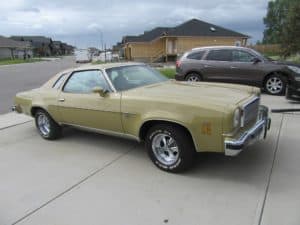 |
||||||||||||||||||||||||||||||||||||||||||||||||||
|
||||||||||||||||||||||||||||||||||||||||||||||||||
70 SS Guy
Hi Wess R,
What do you see wrong with the tail lights shown for the ’71 Chevelle?
The 71s & 72s both had 4 round tail lights, I am not disputing you, I just don’t know what is that you are saying is incorrect. Is there some subtle difference between 71 & 72 that I am missing?
I know 1970 Chevelles intimately because I have owned six of those and know that there is a significant difference between ’69, ’70 & ’71. The 1970 Chevelles had square or to be more accurate, rectangular tail lights which were built into the bumper. The tail lights on the ’69 were built into the sheet metal.
old owner
The tail lights on the 71 SS are not correct.

